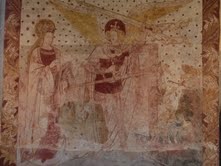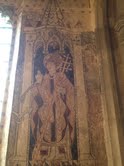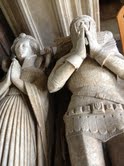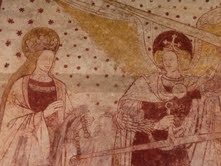 |
| St Mary's, North Leigh |
 |
| St James the Great, South Leigh |

Both show the Resurrection of the Dead, people emerging from their tombs to the sound of angels blowing trumpets. On Our Lord's right (the left of the picture) the good are being taken to heaven; on His left the wicked are being rounded up by devils, who have emerged from the very jaws of hell. The jaws of hell are very graphically illustrated, as a kind of huge fish, with teeth. In both churches the variety of the damned is emphasised: one wears a crown, one has a tonsure, one a mitre...
St James has another wonderful picture on the south wall, near the door, of St Michael weighing a soul. The soul sits in pan of the scales, while devils are trying to pull the other pan down. They will be using the poor fellow's sins to weigh it down, but Our Lady stands by the soul, and seems to be dropping rosary beads into his side of the scales, and indeed it is going down in his favour. What a wonderfully graphic lesson for the worshiper.
 I can usually find something to complain about when looking at the little booklets on the history of the churches. Apart from failing to mention the small matter of the Protestant Revolt (oops!) which is more or less invariable, the good people who wrote the St James the Great one couldn't quite bring themselves to inform readers that 'St Clement of Rome' was actually, er, Pope. This is hardly irrelevant, since it explains the triple tiara he is wearing. It is interesting that the people of this tiny Cotswold village had a devotion to the fourth pope, who is mentioned in the Roman Canon.
I can usually find something to complain about when looking at the little booklets on the history of the churches. Apart from failing to mention the small matter of the Protestant Revolt (oops!) which is more or less invariable, the good people who wrote the St James the Great one couldn't quite bring themselves to inform readers that 'St Clement of Rome' was actually, er, Pope. This is hardly irrelevant, since it explains the triple tiara he is wearing. It is interesting that the people of this tiny Cotswold village had a devotion to the fourth pope, who is mentioned in the Roman Canon.The paintings were uncovered in late 19th Century by a vicar, Gerard Moultrie, whose interest in things Catholic is also evidenced by the fact that it was he who translated one of the most moving English hymns, 'Let all mortal flesh keep silence', which is from the Liturgy of St James. The ones at St Mary's were uncovered in 1864 by the architect G.E. Street, who was working on the church. We owe a lot to these men, who have preserved these striking things from our Catholic past. What the Anglican church-goers have made of them for last century and more I cannot imagine.

St Mary's also has a very impressive Medieval tomb, showing Sir William and Lady Elizabeth Wilcote. Like the paintings, this dates from the 15th Century: a century of great growth and energy in the English Church. Alas, the Requiems they intended for the exquisite Chantry Chapel would have ceased to be said after less than a century.
In future perhaps I should take a proper camera with me; I hardly do these great paintings justice. For what they are worth, the full set is here.

Wonderful history you cover on these walks! Thanks for the write up.
ReplyDeleteYou're welcome!
ReplyDelete